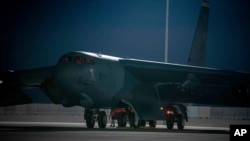U.S. military planners have a growing number of options should the Taliban, or any other group, decide to target American and NATO troops as they prepare to withdraw from Afghanistan.
Two U.S. B-52 bombers arrived at al-Udeid Air Base in Qatar on Monday, charged with providing air cover for the approximately 10,000 U.S. and NATO forces set to depart Afghanistan over the coming months.
The B-52s join two other bombers already in Qatar, as well as the USS Dwight D. Eisenhower aircraft carrier, which was ordered to remain in the region for the start of the drawdown.
Officials said ground forces could also be on the way, in short order.
"I think you can expect there will be an addition of posture in Afghanistan," Pentagon press secretary John Kirby told reporters.
"We have to assume, though we don't want it to be this way, this drawdown could be opposed by the Taliban," he said. "We want to make sure first and foremost that doesn't happen. And secondly, if it does, that we've got enough capability to make sure we can protect our people as they move out of the country."
U.S. President Joe Biden announced earlier this month that he was pulling the approximately 2,500 to 3,500 U.S. troops out of Afghanistan beginning May 1, and that the withdrawal would be completed by early September. But the commander of U.S. forces in Afghanistan said Sunday the withdrawal was already under way.
"We've already begun," General Austin Scott Miller told reporters Sunday in Kabul.
"That means transitioning bases and equipment to the Afghan security forces," he said, adding that when the last U.S. and NATO troops leave, "they must be ready."
Despite such efforts, top military officials and various government watchdogs have warned that the Afghan forces lack the capacity to withstand a military challenge from the Taliban if peace negotiations collapse.
"My concern is the ability of the Afghan military to hold the ground that they're on now without the support they've been used to for many years," U.S. Central Command's General Kenneth "Frank" McKenzie told U.S. lawmakers last week.
Some details of the U.S. withdrawal are still being worked out. Pentagon officials expect the finalized plan to be presented this coming Friday, but they have been looking at ways to continue supporting Afghan forces from afar. Such solutions could even include virtual calls to help Afghanistan's air force keep its planes in the air.
"We're looking at how we can continue to support in a responsible way some of their contractual requirements for things like aviation maintenance," the Pentagon's Kirby said Monday, emphasizing that the U.S. is committed to ending all in-country assistance.
"Our support to the Afghan forces will be primarily financially based," he said.
Despite the planned pullout, Taliban officials have repeatedly threatened to target U.S. and coalition forces if they fail to leave Afghanistan by the start of May — the deadline under an agreement signed between the Taliban and the administration of former U.S. President Donald Trump.








